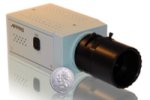Video analytics chip speeds up
May 14, 2010 — by Eric Brown — from the LinuxDevices Archive — 4 viewsTexas Instruments (TI) announced a DaVinci video processor with “smart analytics,” claimed to offer three times the video performance of its predecessor. Designed for video surveillance and security applications, the DMVA2 supports 720P video at 30fps and 1080p at 15fps, and is offered with an IP camera reference design from Appro.
The DMVA2 SoC offers three times the video performance of the entry-level DMVA1 video processor announced last month, claims TI. The new SoC also debuts TI's "Smart Codec Technology," which is said to provide up to five times the bit rate reduction compared to the DMVA1, for improved video quality and network bandwidth.
The DMVA2 is pin- and software- compatible with the DMVA1, as well as with the DM365 and DM368 DaVinci video processors, according to TI.
40 percent faster than the DMVA1
Like the DMVA1, the DMVA2 is equipped with an ARM926EJ-S core. Clock rate is not listed, but TI says the core provides more than 40 percent faster host processor performance than the DMVA1's core, which is clocked at 300MHz.
Like the DMVA1, the SoC also includes a new vision analytics coprocessor, as well as a coprocessor that appears to integrate the new, undefined Smart Codec Technology. The DMVA2 can process H.264 video in high, main, or base profiles, at 720p (30 frames per second) or 1080p (15fps), plus secondary CIF stream, says TI. The SoC supports MPEG-4, MPEG-2 MJPEG and VC1, and enables up to two-megapixel IP camera designs, says the company.
As with the DMVA1, the DMVA2 integrates TI's on-chip, fifth- generation ISP solution. This imaging technology is said to enable enhancements such as video stabilization, noise filtering, auto white balance, auto focus, auto exposure, and edge enhancement. Face detection and recognition are also supported, says the company.
According to TI, the DMVA2 integrates an EMAC, RTC, and an integrated voice codec, all components shared with the DMVA1. TI did not list additional peripheral support, but we assume it is similar or even identical to that of the DMVA1. (The latter offers support for DDR memory, and supplies I/O including USB, I2C, ISIF, SPI, GPIO, AEMIF, VENC, and UARTs.)
IP camera reference design
 As with the DMVA1, the DMVA2 is available in a Linux-ready, IP camera reference design (pictured) co-developed with Appro Photoelectron, in collaboration with Micron's Aptina Imaging division. The latter supplies the DMVA1 reference design's Aptina five-megapixel CMOS imager, which is said to be optimized for low-light performance.
As with the DMVA1, the DMVA2 is available in a Linux-ready, IP camera reference design (pictured) co-developed with Appro Photoelectron, in collaboration with Micron's Aptina Imaging division. The latter supplies the DMVA1 reference design's Aptina five-megapixel CMOS imager, which is said to be optimized for low-light performance.
The DMVA2IPNC-MT5 reference design offers a graphical user interface (GUI) for smart analytics functions, as well as a complete Linux-based IP camera application, including free source code, says TI. The design is said to support camera tamper detection, intelligent motion detection, trip zone, people counting, and streaming metadata.
Availability
The DMVA2 will begin sampling in the second quarter to early adopter video security customers, says TI.
The Appro-manufactured DMVA2IPNC-MT5 IP camera reference design incorporating the SoC is now available for pre-orders at $795, says the company. At the time of writing, however, the DMVA2 reference design page said only that order availability would be "open soon," and the price was listed at $895.
More information may be found here.
This article was originally published on LinuxDevices.com and has been donated to the open source community by QuinStreet Inc. Please visit LinuxToday.com for up-to-date news and articles about Linux and open source.